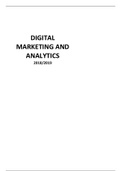DIGITAL
MARKETING AND
ANALYTICS
2018/2019
, WEEK 1
INTRODUCTION TO
DIGITAL MARKETING
1.CHARACTERISTICS OF DIGITAL
MARKETING
BENEFITS OF DIGITAL MARKETING
There are five S:
1.Sell: Grow Sales
2.Serve: Add Value
3.Speak: Get closer to customers
4.Save: reduce costs
5.Sizzle: Expand brand online
DIGITAL VS OFFLINE MARKETING
1.Targeted
2.Real-time results, monitoring and adjustments
3.Product info
Degree of individualization
1.Traditional media: same message to all customers (or
customers in each segment)
,2.New Media: different messages to each customer (or
customers in microsegment) and more information exchange
between customers
Digital campaigns
1.Traditional one-to-many mass marketing communications
2.One-to-one internet based communication
3.Many-to-many communications via the internet medium
2.TOUCHPOINTS
ARTICLE 1.3
TYPES OF TOUCHPOINT
Three types of touchpoints:
-Owned media: company controls the channel. The essence is
content and the customer initiates the contact (if customer is
prepared). The form of communication is interactive between
brand and customer. Examples are the firm’s own website,
supportive own websites, mobile applications of the brand,
social media accounts of the brand.
-Paid Media: company pays for media space or for a third party
to promote its products and initiates the contact. The essence
is advertising and the form of communication is brand to
consumer. Examples are online ads, banner ads in websites or
mobile apps, online pop-up ads, campaign messages,
product/brand placement on online platforms, online
sponsorship and paid search (SEO).
,-Earned media: company customers become the channel. This
is self created, user generated, product of collaboration. The
essence is engagement, the customer initiates the contact and
the form of communication is customer to customer. Examples
are social word-of-mouth, online reviews, articles, interviews
about the brand, blogs, forums, user evaluations, non-paid
search results.
In recent years two new forms of media challenge the
traditional strategies of most marketing organisations:
-Sold: the company invites other marketers to place their
content on its owned media. An example is an e-commerce
retailer selling ad space on its web site.
-Hijacked: company’s asset or campaign is taken hostage by
those who oppose it. An example is the distribution of negative
versions of an ad created by customers.
These types of media are all evolving in four primary ways:
1.Different kinds of media are becoming more
integrated
2.New publishing models are emerging because of the
increasing complexity of consumer needs and of efforts
to address them means marketers can’t do everything.
Marketers are partnering with media publishers to
create deeper marketing experiences and obtain
content and ad sales support.
3.Marketing experiences are becoming more
personally relevant. New kinds of media enable richer
interactions and improve targeting.
, 4.Consumers are engaging more often in real-time
conversations, particularly on social networks.
What is the challenge for marketing organisations?
There are four priorities for them:
1.Think strategically about the role of each media type:
the role of paid media should change and it may be used
to drive consumers to owned media or as a simple
booster.
2.Rebalance time and resources: owned media need a
stream of constant traffic-building programs, fresh
content, and optimized design.
3.Develop a clear community or social networking
strategy: companies need a set of rules for managing
and responding to attacks against the brand. If the
company fails to respond effectively it can run into high
costs.
4.Improve both art and the science of marketing: It is
both and a third dimension is added, execution: teams
need to design campaigns for a number of different
kinds of channels.
ARTICLE 1.1
ATTRIBUTING CONVERSIONS IN A MULTICHANNEL ONLINE
MARKETING ENVIRONMENT: EMPIRICAL MODEL AND FIELD
EXPERIMENT
In many product and service categories customers visit a firm’s
website several times through multiple channels before a
conversion occurs. One visit can influence subsequent visits to
the website, through the same channels or others-
,Traditional metrics do not take into account the timing and
sequence of earlier communications and the resulting
carryover and spillover effects. Using them can lead to biased
and misleading inferences and sub-optimal allocation of
marketing budgets across channels and campaigns.
An integrated model to estimate carryover and spillover effects
of prior touches is necessary.
The article proposes a three-level measurement model for
estimating the carryover and spillover effects at both the
stage of visiting and purchasing. The model accounts for:
1.The heterogeneity across customers’ consideration of
channels through which to visit the website
2.The Carryover and spillover effects of prior marketing
interventions that contribute to website visits
3.Subsequent purchase conversions
The purchase decision hierarchy involves a series of stages:
1.The consideration stage
2.The visit stage
3.The purchase stage
There is a distinction between:
1.Customer initiated channels (they seek out info on
their own)
2.Firm initiated channels
Customers’ prior visits through a specific channel have
carryover effects in the same channel and spillover effects
across channels at both visit and purchase stages.
, At the visit stage, the spillover is the impact of prior visits
through a given channel on the probability of a visit through
that specific channel.
At the purchase stage, the spillover is the impact of prior visits
through a given channel on the probability of making a
purchase through that specific channel.
The customers decide on whether to visit the channel in
relation to the marginal benefits and the marginal costs (effort
of finding and processing info).
Conclusions
The study finds significant spillover effects of firm initiated
channels to customer initiated channels at both the visit and
purchase stages, which also influence visits through other
channels.
3. DIGITAL DATA TYPES
The most used classification in practice is the following:
1.Online On-Site Data
Data that is available on the web (through data or web scraping)
Web scraping is the process of collecting data from websites,
social media platforms through scraper softwares and
importing to local data base in xls, sql or other format.
2.Clickstream/Behavioral Data
Describes what people do online, when and how (actual
customer behavior). An example is Google Analytics.





